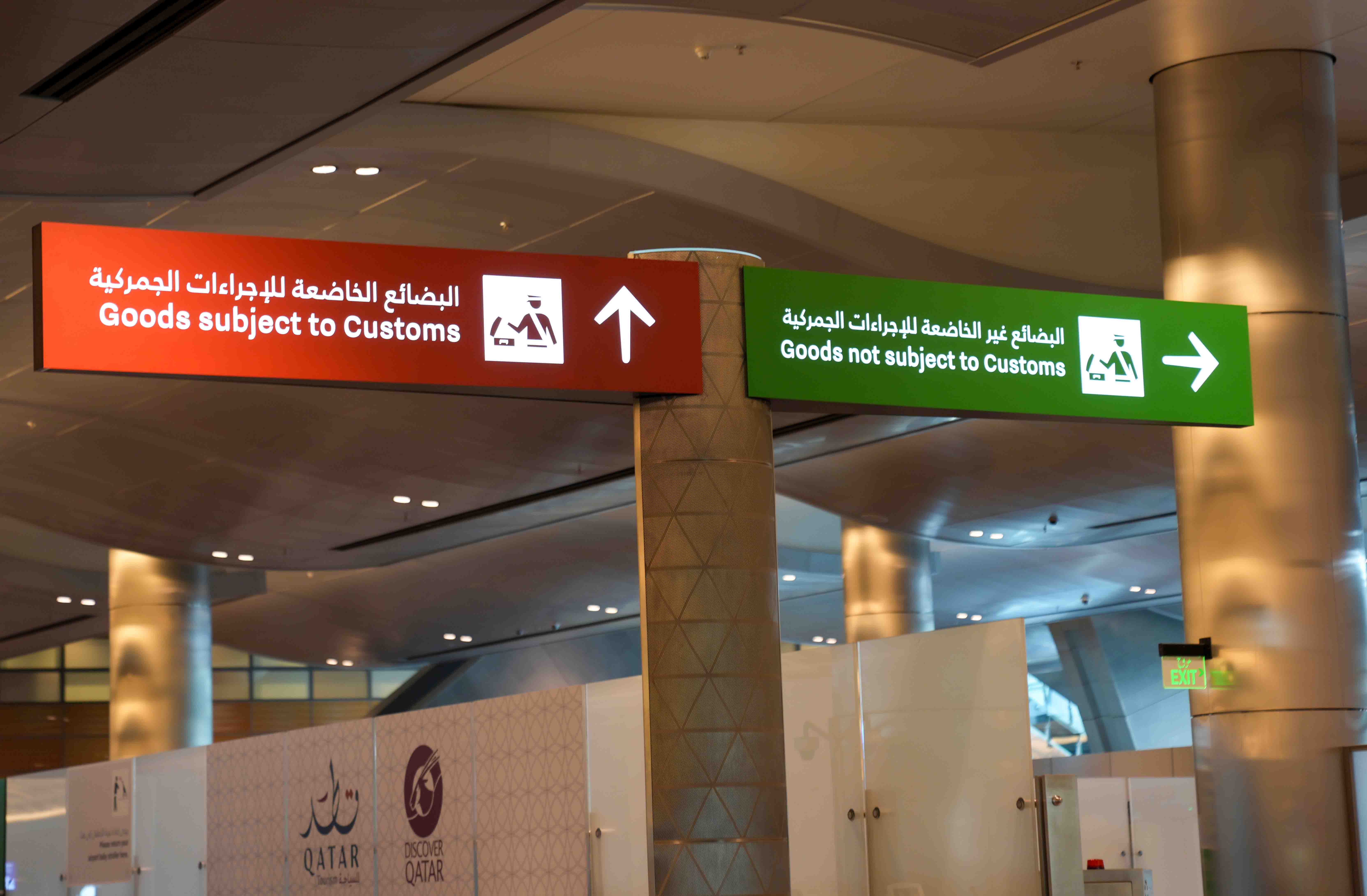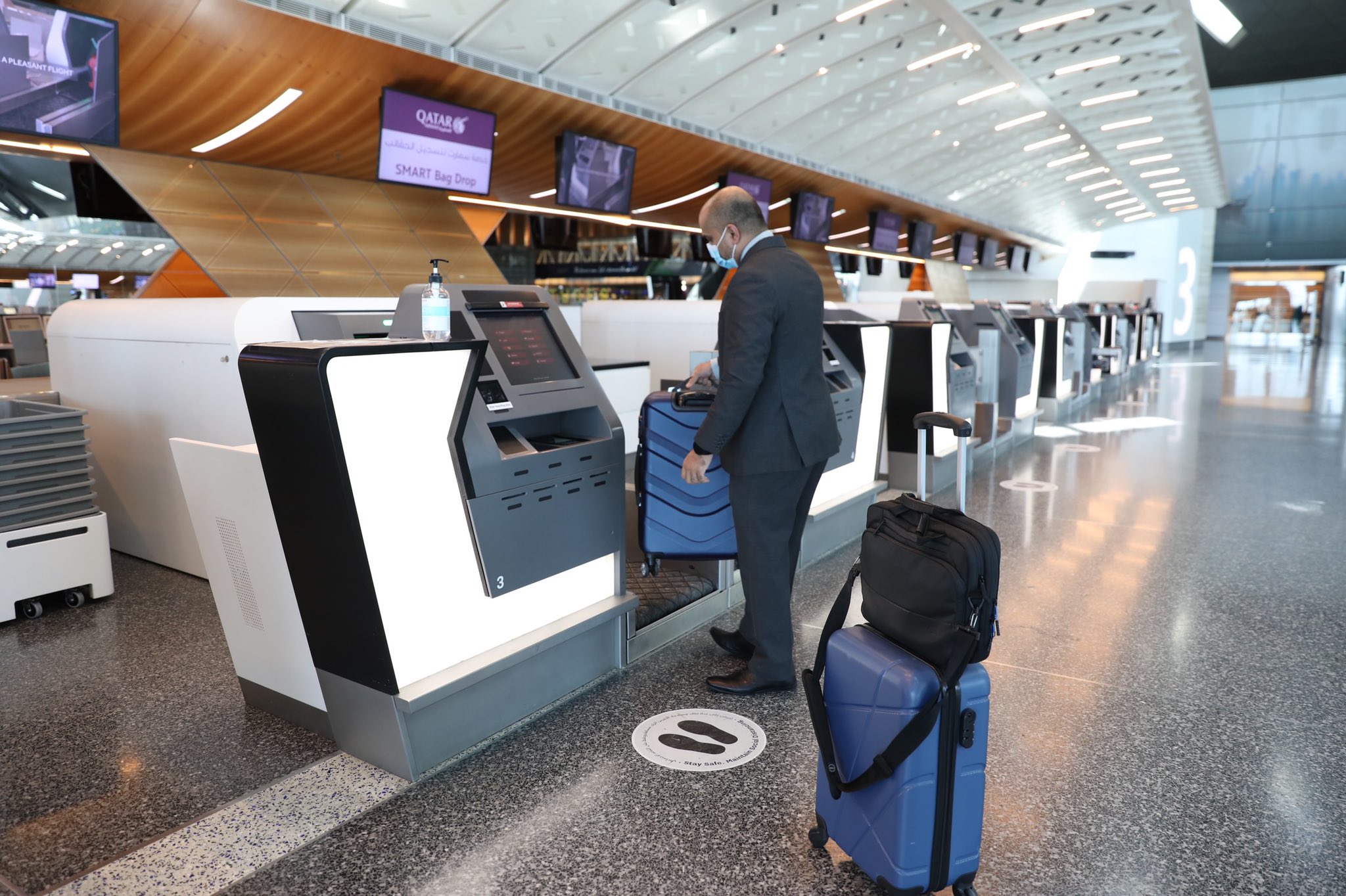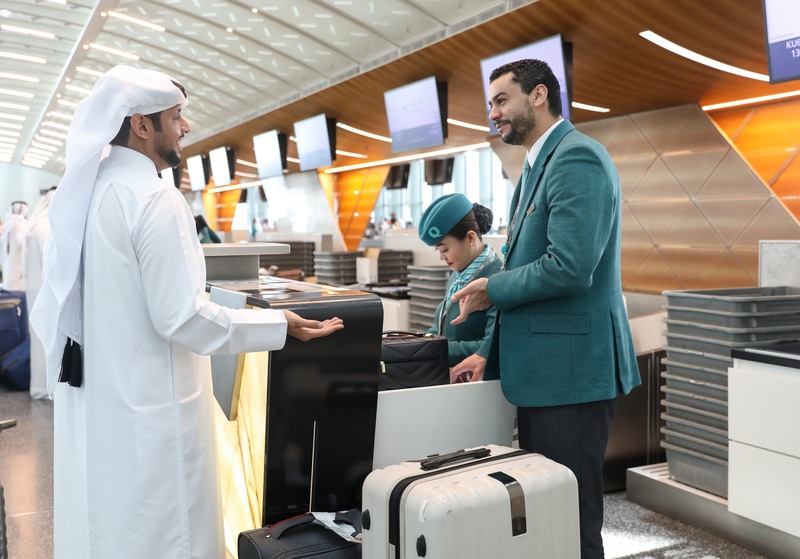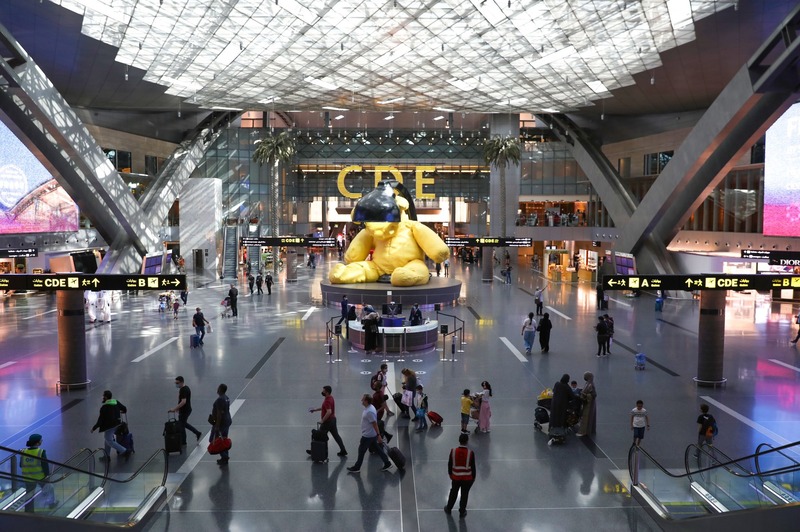.jpg)
When traveling through Qatar Airport, it's crucial to be aware of the restrictions on dangerous goods and security-restricted items in passenger baggage. These items can pose risks to health, safety, property, or the environment. Familiarize yourself with the list of allowed and prohibited items before packing.
Some dangerous goods may be permitted in carry-on bags, checked luggage, or on your person, while others are completely forbidden. If you need to transport any dangerous goods that require prior approval, contact Qatar Airways at least 96 hours before your flight.
Additionally, Qatar Customs has specific restrictions on items such as weapons, explosives, narcotics, and alcoholic beverages, which are strictly prohibited. Pork products are also not allowed due to Islamic laws. Certain items like electric devices and tobacco products are restricted and may require permits or have quantity limits.
When arriving at Hamad International Airport, ensure you declare any restricted items at the customs counter. Use the Green Channel if you have nothing to declare and the Red Channel if you have items to declare, such as exceeding permitted limits of foreign currency or personal items valued over QAR 3,000.
Always check the latest regulations to avoid fines or penalties. By following these guidelines, you can ensure a smoother and safer travel experience while complying with necessary regulations.

Ammunition
-
Passengers may carry ammunition in their checked baggage, but it must be declared at check-in. Ensure you have the necessary licenses and documentation required by the local authorities in both the departure and arrival states.
-
Only ammunition classified as UN0012 or UN0014 is permitted, with a maximum gross weight of 5 kg per person. This classification can be found in the “Safety Data Sheet” (SDS) of the ammunition under Section 14.
-
Ammunition must be packed separately from firearms in a robust, secure container made of wood, metal, or fiberboard. The container should be designed to carry small quantities and must be lockable.
-
Ammunition must only be for individual use. Combining ammunition for multiple passengers into one package is not allowed.
Firearms
-
Firearms can be transported in checked baggage if declared at check-in. Passengers must sign a "Declaration of Surrender of Firearms" and provide the required licenses and documentation to the relevant local authorities.
-
Firearms must be unloaded and securely packed in a hard-sided, lockable container. The container must remain locked throughout transit.
-
Ensure all firearms meet the airline's regulations for safe transport.
Batteries and Battery-Powered Devices
-
All battery-powered devices carried in checked baggage must be switched off. Avoid placing them in sleep or hibernation mode to prevent unintentional activation.
-
Spare batteries are allowed only in hand baggage. Protect battery terminals individually to prevent short circuits by using original retail packaging, adhesive tape over terminals, or separate plastic bags/pouches.
-
Lithium batteries must comply with the UN Manual of Tests and Criteria (Part III, subsection 38.3). Examples include power banks and jump-starters.
By adhering to these guidelines, you can ensure a smooth journey while complying with Qatar Airways' safety protocols. For further clarification or additional requirements, contact Qatar Airways directly before your flight.
Drones (Remotely Piloted Aircraft System – RPAS)
-
Hand Baggage:
You can carry drones in your hand baggage, with or without batteries. However, if the battery’s watt-hour (Wh) rating exceeds 100 Wh but is under 160 Wh, you must obtain prior approval from Qatar Airways. Batteries exceeding 160 Wh are strictly prohibited in both hand and checked baggage. -
Checked Baggage:
Drones without batteries can be packed in your checked baggage. If the batteries are removed, they must be carried in your hand baggage and must comply with regulations for spare batteries. -
Important Restrictions:
-
Drone batteries must not be charged during the flight for safety reasons.
-
Some countries impose restrictions on drones, including their carriage and entry. Before traveling, always check the local rules and regulations of your destination country to ensure compliance.
-
E-Cigarettes
-
Hand Baggage Only:
You can carry e-cigarettes, including e-cigars, e-pipes, and other personal vaporizers containing batteries, in your hand baggage. Recharging these devices or their batteries on board the aircraft is strictly prohibited. -
Country-Specific Regulations:
Some countries may have restrictions that affect the carriage of e-cigarettes. Always refer to the rules of both your origin and destination countries before traveling to avoid issues. -
E-Cigarette Lighters:
-
You may carry one e-cigarette lighter (e.g., laser plasma lighter, tesla coil lighter, flux lighter, arc lighter, or double arc lighter) powered by lithium batteries.
-
The lighter must be carried on your person and protected by a safety cap to prevent accidental activation. It cannot be packed in hand or checked baggage.
-
Recharging these lighters during the flight is not permitted.
-
Portable Electronic Devices (PEDs)
-
Hand and Checked Baggage:
PEDs such as cameras, mobile phones, laptops, tablets, or other battery-powered equipment can be carried in both hand and checked baggage. If packed in checked baggage:-
Ensure all devices are completely switched off (not just in sleep or hibernation mode).
-
Take precautions to prevent accidental activation or damage during transit.
-
-
Battery Regulations:
-
Devices powered by lithium-ion batteries must have a watt-hour (Wh) rating of 100 Wh or less. Lithium metal batteries should contain no more than 2g of lithium content.
-
You may carry a maximum of 15 PEDs per passenger.
-
-
Heat-Producing Equipment:
For battery-powered equipment capable of generating extreme heat (e.g., underwater high-intensity lamps):-
Separate the heat-producing component from the battery to prevent fire hazards. This can involve removing the battery, fuse, or other components.
-
Removed batteries must be protected against short circuits (e.g., by placing them in protective cases) and carried in your hand baggage.
-
-
Special Restrictions for Certain Devices:
Some PEDs like power tools (e.g., drills, cordless saws, nail guns) may have additional restrictions due to security concerns. Always check Qatar Airways’ guidelines for "Security Restricted Items" before packing these devices.
General Tips for Compliance
-
Know Your Destination’s Rules: Many countries have specific regulations regarding drones and electronic devices. Research local laws before traveling to avoid confiscation or fines.
-
Safety First: Avoid charging any battery-powered device during the flight to minimize risks of overheating or fire.
-
Pack Smartly: Ensure all batteries are properly stored to prevent short circuits—use protective cases or original packaging whenever possible.
-
Seek Approval When Necessary: For high-capacity batteries (100–160 Wh), contact Qatar Airways in advance for approval to carry them in your hand baggage.
By following these detailed guidelines, you’ll ensure a hassle-free experience while traveling with drones, e-cigarettes, and PEDs on Qatar Airways!
Carry-on vs. Checked Baggage
Carry-on Baggage
Most PEDs are allowed and preferred in carry-on baggage. This includes:
-
Smartphones, tablets, laptops, e-readers
-
Cameras and video cameras
-
Portable gaming devices
-
Medical devices like portable oxygen concentrators (POCs), automated external defibrillators (AEDs), and continuous positive airway pressure (CPAP) machines
-
Power tools (subject to additional restrictions)
Checked Baggage
While many PEDs are allowed in checked baggage, it's crucial to follow these rules:
-
Ensure all devices are completely powered off, not just in sleep or hibernation mode
-
Pack devices securely to prevent damage or accidental activation
-
Remove batteries from devices if possible, especially for items like power tools
Battery Specifications and Limits
Lithium-ion Batteries
-
General limit: 100 watt-hours (Wh)
-
With airline approval: Up to 160 Wh for PEDs and portable medical electronic devices (PMEDs)
-
Spare batteries: Maximum of 2 spares between 100-160 Wh
Lithium Metal Batteries
-
General limit: 2 grams of lithium content
-
For PMEDs only: Up to 8 grams with airline approval
-
Spare batteries: Maximum of 2 spares for PMEDs
Other Battery Types
-
Includes dry batteries, nickel-cadmium batteries, and alkaline batteries
-
Generally allowed in both carry-on and checked baggage
-
Maximum of 20 spare batteries total (including lithium batteries)
Smart Luggage and Rideable Suitcases
Permitted
-
Luggage with removable lithium batteries (up to 100 Wh)
-
Devices powered solely by lithium button or coin cells
Restricted
-
Luggage with non-removable lithium batteries (strictly prohibited)
-
Batteries exceeding 160 Wh (not permitted in carry-on or checked baggage)
Special Cases
-
Batteries between 100-160 Wh: Allowed with prior airline approval, must be removed and carried in hand baggage
-
Low-power devices (under 0.3g lithium for metal batteries or 2.7 Wh for ion batteries): Allowed if completely switchable
Safety Precautions
Handling Spare Batteries
-
Always carry spare batteries and power banks in carry-on baggage
-
Protect battery terminals to prevent short circuits (use original packaging or insulate with tape)
-
Keep batteries separated from metal objects like keys or coins
During Flight
-
Avoid charging devices or power banks during the flight
-
Don't leave devices charging unattended
-
Switch off devices when not in use to prevent overheating
-
Alert flight crew if a device becomes unusually warm
Special Considerations
-
For underwater high-intensity lamps or similar heat-producing equipment, separate the heat-producing component from the battery
-
Some airlines may have additional restrictions on power tools, drills, nail guns, etc.

Additional Tips
-
Always check with your specific airline for their most up-to-date policies
-
Consider the regulations of all countries you'll be traveling through, as they may vary
-
If traveling with medical devices, carry documentation from your healthcare provider
-
For items not meeting standard requirements, inquire about shipping them as cargo
By adhering to these detailed guidelines, you can ensure compliance with airline regulations and maintain safety throughout your journey while traveling with your essential electronic devices.
Lithium Battery-Powered Vehicles
-
Small vehicles powered by lithium batteries are strictly prohibited in both hand and checked baggage.
-
This ban applies regardless of the battery's watt-hour rating and even if the batteries are removed.
-
Examples of prohibited items include Solowheels, hoverboards, mini-Segways, e-scooters, and balance wheels.
-
Smart vehicles are also not permitted.
-
For rideable suitcases and self-propelling baggage, consult the "Smart baggage and rideable suitcases" section for specific rules.
Compressed Gas Items
-
Avalanche Rescue Backpacks:
-
One backpack containing Division 2.2 compressed gas cartridges is allowed.
-
It may include a pyrotechnic trigger with up to 200mg of Division 1.4S explosives.
-
Pack carefully to prevent accidental activation.
-
Airbags must have pressure relief valves.
-
-
Gas Cylinders for Mechanical Limbs:
-
Small cylinders of non-flammable, non-toxic Division 2.2 gas are permitted.
-
Carry spare cylinders as needed for your journey.
-
-
Non-flammable Gas Cartridges:
-
Allowed in self-inflating safety devices like life vests.
-
Limit: Two cartridges per device, two devices per person, and two spare cartridges per device.
-
For other uses (e.g., bicycle tire inflators), up to four cartridges per person are allowed, each not exceeding 28g capacity.
-
-
Hair Curlers with Hydrocarbon Gas:
-
One curler is permitted in hand or checked baggage.
-
The heating element must have a secure safety cover.
-
Usage on board is prohibited, and gas refills are not allowed.
-
-
Equipment with Compressed Gas:
-
Items like small refrigerators, portable ACs, water dispensers, and ice makers may be exempt from regulations if undamaged and meeting specific criteria:
-
Non-flammable, non-toxic gas: Up to 12kg allowed.
-
Flammable, non-toxic gas: Less than 100g allowed, with strict design and safety requirements.
-
-
Always check with your airline for the most up-to-date information and any additional restrictions they may have in place. When in doubt, it's best to leave potentially problematic items at home to ensure a smooth travel experience.
Camping Stoves and Fuel Containers
If you plan to carry camping stoves or fuel containers in your checked baggage, you must adhere to strict guidelines to ensure safety. These items are classified as dangerous goods due to their potential to hold flammable liquids. Here’s what you need to do:
-
Empty the Fuel Tank or Container Completely:
-
Ensure that the fuel tank or container is fully drained of all liquid fuel.
-
To remove residual fuel, drain the tank or container for at least one hour, then leave it uncapped for a minimum of six hours. This allows any remaining fuel to evaporate completely.
-
Alternatively, you can add cooking oil to the tank or container. The cooking oil raises the flash point of any residual liquid above the flash point of flammable liquids. After this process, empty the tank or container thoroughly.
-
-
Secure the Caps:
-
Once the fuel tank or container is empty, ensure that its cap is securely fastened to prevent leakage or contamination during transit.
-
-
Wrap and Pack Safely:
-
Wrap the camping stove or empty fuel container in absorbent material such as paper towels.
-
Place the wrapped item in a polyethylene bag (or an equivalent type of bag) and seal it properly. You can use elastic bands or twine to close the bag securely.
-
-
Brand-New Camping Stoves or Fuel Containers:
-
If you are carrying brand-new camping stoves or fuel containers that have never contained flammable liquid fuel, they are not considered dangerous goods and can be carried without restrictions.
-
However, it is advisable to contact your airline (e.g., Qatar Airways) in advance for confirmation.
-
For further clarification or approval regarding camping stoves and fuel containers, reach out to the airline directly.
Fuel Cells
Fuel cells used for powering portable electronic devices (PEDs) like cameras, mobile phones, laptops, and camcorders can be carried in your hand baggage under specific conditions:
-
Main Fuel Cells:
-
You may carry fuel cells containing fuel that powers your electronic devices in your hand baggage.
-
-
Spare Fuel Cell Cartridges:
-
You are allowed to carry up to two spare fuel cell cartridges in your hand baggage.
-
-
Additional Restrictions:
-
Additional rules may apply depending on the type of fuel cell and airline policies. Contact your airline for detailed information about these restrictions.
-
Alcoholic Beverages
Alcoholic beverages can be carried in both checked and hand baggage, but there are specific limitations based on alcohol content:
-
Alcohol Content Between 24% and 70%:
-
Beverages with alcohol content between 24% and 70% by volume must be stored in receptacles that do not exceed 5 liters each.
-
The total quantity of alcoholic beverages per passenger must not exceed 5 liters.
-
-
Alcohol Content Below 24%:
-
Alcoholic beverages with less than 24% alcohol by volume are not classified as dangerous goods under regulations. However, other restrictions may still apply.
-
-
Hand Baggage Considerations:
-
When carrying alcoholic beverages in hand baggage, quantities may be further restricted due to regulations on liquids, aerosols, and gels (LAGs). Check country-specific customs regulations before packing.
-
Liquids and Gels
When packing liquids, gels, pastes, and aerosols in your hand baggage, follow these detailed guidelines:
-
Container Size Limit:
-
Each container must hold no more than 100ml (3.4oz).
-
Containers larger than 100ml will not be accepted even if they are only partially filled.
-
-
Transparent Bag Requirements:
-
All containers should be placed in a transparent, resealable bag that is either quart-sized or liter-sized.
-
The bag should measure no larger than 20x20cm (8x8in).
-
Ensure all items fit comfortably within the plastic bag without overcrowding.
-
-
Airport Security Screening:
-
Be prepared to present your transparent bag separately during security screening at the airport.
-
-
Exemptions for Special Needs:
-
If you are traveling with infants or have special dietary requirements, you may carry reasonable quantities of baby food or other necessary items for the duration of your flight.
-
Medications and special dietary items may also be exempt from liquid restrictions. Check with your airline for specific guidelines regarding exemptions.
-
General Recommendations
-
Always contact your airline (e.g., Qatar Airways) ahead of time if you’re unsure about specific items you wish to carry.
-
Review country-specific customs regulations for additional restrictions on liquids, alcoholic beverages, and other items.
-
For more information about exemptions related to baby food, medication, or dietary requirements during travel, consult the airline’s FAQs or customer service team.
By following these detailed tips and guidelines, you can ensure compliance with airline regulations while packing safely for your journey!
Liquid Nitrogen in Insulated Packaging (Dry Shipper)
What's Allowed:
-
Insulated packaging containing refrigerated liquid nitrogen (dry shipper)
-
Can be carried in both hand and checked baggage
Important Details:
-
The liquid nitrogen must be fully absorbed in a porous material
-
The package must be designed to prevent any pressure build-up
-
It should not allow the release of any refrigerated liquid nitrogen, regardless of the orientation of the package
-
The insulated packaging can only contain non-dangerous goods
Safety Tip:
Always double-check the seal on your dry shipper before travel to ensure no leakage.
Oxygen or Air Cylinders for Medical Use
What's Allowed:
-
Oxygen or air cylinders required for medical purposes
-
Can be carried in both hand and checked baggage
Important Details:
-
Each cylinder must not exceed a gross weight of 5kg
-
Airline approval is required before travel
-
Personal medical oxygen devices using liquid oxygen are strictly prohibited in all types of baggage and on your person
Safety Tip:
Inform the airline well in advance about your need to carry oxygen cylinders to ensure smooth travel arrangements.
Radio-Isotopic Cardiac Pacemakers
What's Allowed:
-
Radio-isotopic cardiac pacemakers or similar devices
-
Includes devices powered by lithium batteries
-
Can be implanted in the body or worn externally
Safety Tip:
Carry documentation from your doctor about your pacemaker in case of security questions.
Non-Infectious Specimens with Flammable Liquids
What's Allowed:
-
Non-infectious specimens packed with small quantities of flammable liquid
-
Can be carried in both hand and checked baggage
Packaging Requirements:
-
Specimen Preparation:
-
Option A: Wrap specimens in paper towel/cheesecloth moistened with alcohol, alcohol solution, or formaldehyde solution. Place in a heat-sealed plastic bag with no more than 30ml of free liquid.
-
Option B: Place specimens in vials or rigid containers with a maximum of 30ml of alcohol or alcohol solution.
-
-
Primary Packaging:
-
Place prepared specimens in a heat-sealed plastic bag.
-
-
Secondary Packaging:
-
Put the primary package into another heat-sealed plastic bag made of absorbent material.
-
-
Outer Packaging:
-
Place the secondary package in strong outer packaging with suitable cushioning material.
-
Additional Requirements:
-
Total quantity of flammable liquid per outer package must not exceed 1 liter
-
Mark the package: "Scientific research specimens, not restricted as per special provision A180 applies
Safety Tip:
Use high-quality, durable plastic bags to minimize the risk of leakage during transport.

Thermometers
Mercury Thermometers (Medical or Clinical):
-
Allowed: One mercury thermometer for personal use
-
Must be in checked baggage only
-
Must be packed in a protective case
Thermometers or Barometers (for Official Use):
-
Allowed in hand baggage with airline approval
-
Only for representatives of government weather bureaus or similar official agencies
-
Must be packed in strong outer packaging with a sealed inner liner or a strong leak-proof and puncture-resistant bag
-
Packaging must prevent mercury escape regardless of position
Safety Tip:
For mercury thermometers, consider using a hard plastic case with foam padding for extra protection.
Mobility Aids
General Guidelines:
-
Acceptable for passengers with disabilities, health issues, age-related restrictions, or temporary mobility problems
Battery-Powered Mobility Aids with Non-Spillable Batteries:
-
Allowed: Wheelchairs or similar devices with wet non-spillable, nickel-metal hydride, or dry batteries
-
Must be in checked baggage
-
Airline approval required
-
Prevent unintentional activation
-
Non-spillable batteries must not contain free or unabsorbed liquid
-
Removed batteries must be in strong, rigid packaging for cargo storage
-
Spare battery allowance: One wet non-spillable or two nickel-metal hydride/dry batteries
Battery-Powered Mobility Aids with Lithium Batteries:
-
Allowed: Wheelchairs or similar devices with lithium-ion batteries
-
Must be in checked baggage
-
Airline approval required
-
No watt-hour (Wh) limit for attached batteries
-
Removed batteries: Maximum 300Wh
-
Carry removed and spare batteries in protective pouches in the passenger cabin
-
Spare battery allowance: One up to 300Wh or two up to 160Wh each
-
Properly pack removed batteries to prevent short-circuiting or damage
Battery-Powered Mobility Aids with Spillable Batteries:
-
Allowed: Wheelchairs or similar devices with spillable batteries
-
Must be in checked baggage
-
Airline approval required
-
Use spill-resistant vent caps where possible
-
If the device can't always be upright or doesn't adequately protect the battery, remove the battery
-
Removed battery requirements:
-
Strong, rigid, leak-tight packaging impervious to battery fluid
-
Protected from short circuits
-
Secured upright
-
Surrounded by compatible absorbent material
-
Marked "BATTERY, WET, WITH WHEELCHAIR" or "BATTERY, WET, WITH MOBILITY AID"
-
Attach "Corrosive" and "Package Orientation" labels
-
Safety Tip:
For all mobility aids, especially those with batteries, contact the airline well in advance to discuss specific requirements and obtain necessary approvals.
Remember, regulations can vary slightly between airlines and countries, so always check with your specific airline and relevant authorities before traveling with any restricted items or dangerous goods.
Chemical Agent Monitoring Equipment
For staff members of the Organization for the Prohibition of Chemical Weapons (OPCW) on official travel:
-
You may carry chemical agent monitoring equipment with proper approval.
-
Allowed devices include:
-
Chemical Agent Monitor (CAM)
-
Rapid Alarm and Identification Device Monitor (RAID-M)
-
-
Important conditions:
-
Devices must not contain lithium batteries
-
Equipment must be securely packed
-
Any radioactive material must not exceed activity limits specified in Table 10.3.C of the IATA Dangerous Goods Regulations
-
-
Always contact the airline for specific approval and additional information
Dry Ice (Solid Carbon Dioxide) for Perishables
-
Maximum allowance: 2.5kg of dry ice
-
Can be carried in both checked and hand baggage
-
Must be used with perishable goods not classified as dangerous
-
Packaging requirements:
-
Must allow for the release of carbon dioxide gas
-
In checked baggage, packages must be:
-
Marked with the net weight of dry ice
-
Labeled "DRY ICE"
-
-
-
Consider that dry ice sublimates (turns directly from solid to gas), so factor in travel time when determining how much to pack
Internal Combustion or Fuel Cell Engines
These are only allowed in checked baggage under strict conditions:
-
Must not contain any other dangerous goods or batteries
-
Fuel requirements:
-
Either powered by a fuel that doesn't meet dangerous goods classification criteria, or
-
The fuel tank must be completely empty or properly flushed and purged of vapors
-
-
Documentation:
-
Passenger must provide written or electronic proof that flushing and purging procedures have been followed
-
-
Additional safety measures:
-
Entire fuel system must have no free liquid
-
All fuel lines must be sealed, capped, or securely connected to the machinery
-
Matches and Cigarette Lighters
-
Allowed only when carried on your person (not in bags)
-
You may carry:
-
One box of safety matches, or
-
One small cigarette lighter
-
-
Lighter specifications:
-
Must not contain unabsorbed liquid fuel (except liquefied gas)
-
Should require two independent actions to ignite
-
-
Prohibited items:
-
Matches or lighters in checked or hand baggage
-
Lighter fuel and refills
-
"Strike anywhere" matches
-
"Blue flame" or "cigar" lighters
-
Lithium battery-powered lighters (e.g., plasma, tesla coil, flux, arc, or double arc lighters) without safety caps
-
Non-radioactive Medicinal and Toiletry Items
Allowed in both checked and hand baggage:
-
Includes aerosols like hairsprays, perfumes, colognes, and alcohol-containing medicines
-
Also covers non-flammable, non-toxic aerosols (Division 2.2) for sporting or home use
-
Quantity limits:
-
Total net quantity must not exceed 2kg or 2L
-
Each individual item limited to 0.5kg or 0.5L
-
-
Safety requirement: Aerosol release valves must be protected by a cap or other means
-
Note: Hand baggage quantities may be further restricted due to LAGs (Liquids, Aerosols, and Gels) regulations
Permeation Devices
-
Allowed only in checked baggage
-
Used for calibrating air quality monitoring equipment
-
Must comply with IATA Dangerous Goods Regulations Special Provision A41
-
Always check with the airline for any additional restrictions or requirements
Security-type Equipment
-
Generally prohibited if incorporating dangerous goods (e.g., pyrotechnic material, lithium batteries)
-
This includes items like attaché cases, cash boxes, and cash bags
-
Some security equipment may be allowed in checked baggage under specific conditions
-
Always consult with the airline for detailed requirements and approvals
Powder-like Substances
-
Hand baggage restrictions:
-
Containers exceeding 350ml will undergo additional screening
-
May be prohibited depending on the results of screening
-
-
Checked baggage: No quantity restrictions
-
Exceptions to restrictions:
-
Medically prescribed powders
-
Baby formula
-
Human remains
-
-
Duty-free purchases:
-
Must be placed in tightly sealed Security Tamper-Evident Bags (STEB)
-
-
Special considerations for travel to/from specific countries (e.g., Australia, New Zealand, Qatar to USA)
Remember, regulations can change, and individual airlines may have additional restrictions. Always check with your airline well in advance of your travel date when planning to carry any potentially restricted items. It's also wise to carry any necessary documentation, such as medical prescriptions or approvals, to avoid issues at security checkpoints.
Blunt Instruments
Blunt instruments that could potentially be used as weapons are prohibited in the cabin but allowed in checked baggage. This category includes:
-
Baseball and softball bats
-
Cricket bats
-
Golf clubs
-
Hockey sticks
-
Lacrosse sticks
-
Billiard, snooker, and pool cues
-
Martial arts equipment (e.g., nunchucks, kubatons, tonfa)
-
Clubs and batons (billy clubs, blackjacks, night sticks)
-
Hammers and mallets
-
Fishing rods (when they can be used as a bludgeon)
The key consideration is whether the item could cause serious injury if used to strike someone. Even seemingly innocuous objects like heavy flashlights or walking sticks might fall into this category if they're sturdy enough to be used as weapons.
Explosives and Incendiary Devices
These items are strictly prohibited both in carry-on and checked baggage, with very few exceptions:
-
Ammunition (may be allowed in checked baggage with airline approval)
-
Blasting caps
-
Detonators and fuses
-
Mines, grenades, and other explosive military stores
-
Dynamite, gunpowder, and plastic explosives
-
Fireworks and other pyrotechnics
-
Smoke-generating canisters or cartridges
-
Flares (road flares or marine flares)
-
Explosive train set pellets or caps
-
Party poppers or snappers
-
Tear gas or pepper spray
-
Flammable liquid fuel
-
Gas torches
Even realistic replicas of these items are prohibited. The primary concern is the potential for these items to cause catastrophic damage to an aircraft or be used in acts of terrorism.

Guns and Firearms
Firearms and similar devices are not allowed in the cabin but may be transported in checked baggage with proper authorization:
-
Pistols, revolvers, rifles, and shotguns
-
Toy guns, replicas, and imitation firearms
-
Paintball markers
-
Airsoft guns
-
BB guns
-
Flare pistols and starter pistols
-
Components of firearms (except telescopic sights)
-
Compressed air and CO2 guns
-
Pellet guns and ball bearing guns
-
Harpoon guns and spear guns
-
Bows, crossbows, and arrows
-
Slingshots and catapults
The concern here is not just the potential for these items to be used as weapons, but also the panic and confusion they could cause if mistaken for real firearms during a flight.
Electro-shock Weapons and Disabling Devices
These items are completely forbidden on flights, both in carry-on and checked baggage:
-
Tasers and stun guns
-
Cattle prods
-
Stun batons
-
Electroshock dart guns
-
Animal stunners and animal killers
-
Disabling chemicals, gases, and sprays (e.g., mace, pepper spray, tear gas, acid sprays)
-
Bear spray or other animal repellent sprays
These devices are prohibited due to their potential to incapacitate crew members or other passengers, which could compromise flight safety.
Sharp Objects
Sharp objects are generally prohibited in the cabin but allowed in checked baggage:
-
Axes and hatchets
-
Ice axes and ice picks
-
Meat cleavers
-
Razor blades (except those in cartridges)
-
Box cutters
-
Utility knives
-
Knives with blades over 6cm
-
Scissors with blades over 6cm (measured from the fulcrum)
-
Swords and sabers
-
Throwing stars
-
Skates with removable blades
The 6cm blade length rule for knives and scissors is a common standard, but some airlines or countries may have stricter limits.
Workers' Tools
Many tools that could potentially be used as weapons must be placed in checked baggage:
-
Crowbars
-
Drills and drill bits (including cordless portable power drills)
-
Screwdrivers and chisels over 6cm in length
-
Wrenches and pliers over 7 inches long
-
Saws (including cordless portable power saws)
-
Blowtorches
-
Bolt guns and nail guns
-
Hammers
-
Soldering irons
-
Welding equipment
The concern with these items is their potential use as improvised weapons or tools for tampering with aircraft systems.
Remember, these restrictions can vary slightly between airlines and countries. Always check with your specific airline and review the latest regulations from aviation authorities like the TSA (in the US) or EASA (in Europe) before packing for your flight. When in doubt, it's best to leave questionable items at home or pack them in your checked baggage.

.jpg)












.jpg)

.jpg)
.jpg)










.jpg)



















.jpg)







.png)